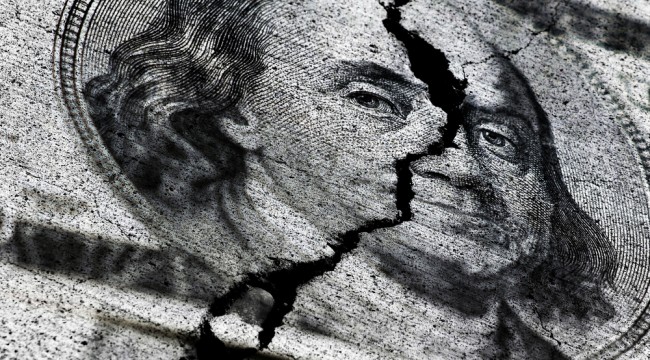Four Market Signals That the Crack-Up’s Begun
Easy money is always the wrong medicine for what ails the market.
The inflated and unsustainable growth that the Greenspan Fed engineered by encouraging Main Street households to stage a massive raid on their “home ATMs” has sharply reversed… and properly so.
This is no small number. Compared to the peak MEW (Mortgage Equity Withdrawal) rate of 8% of disposal income, today’s negative 2% rate means there has been about a $1 trillion downward swing in household “spending.”
Our Keynesian central bankers lament this as a loss of “aggregate demand.” And they intend to remedy the problem by printing more money. In truth, it was always phony demand. It could not be sustained and had not been earned through production. Its disappearance simply marks the fact that households have been forced back to the old-fashioned virtue of “living within their means.”
Stated differently, the supply side is back in charge after a 30-year spree of one-time debt and leverage expansion. Consumer spending now depends on income, which means production, investment and enterprise are once again the source of growth, jobs and true national wealth.
The implication is that our monetary politburo is out of business. “Monetary accommodation” is nothing more than a one-time parlor trick of central bankers.
Unfortunately, like the politburo in the Kremlin, the incumbents in the Eccles Building will not stop until they are finally chased from office by a massive uprising of the people. That is: Savers, workers and entrepreneurs of America who have been shafted by the bubble finance policies of our monetary central planners.
We’re in the crack-up phase now. As such, four things are going to shape the way the economy and the markets unfold as we go forward.
First, you are going to see increasing desperation and extreme central bank financial repression. This is because central banks have painted themselves so deep into the corner that they’re lost and desperate.
Almost week by week, we have another central bank — most recently it was Sweden — lowering their money market rates into negative territory. The Swiss National Bank is already there. Denmark’s Nationalbank is there. The European Central Bank is there on the deposit rate. The Bank of Japan is also there.
All of the central banks of the world now are desperately driving interest rates into negative territory. I believe that they’re lost. They’re in a race to the bottom whether they acknowledge it or not.
The People’s Bank of China, for example, can’t sit still much longer when the renminbi has appreciated something like 30% against the Japanese yen because of the massive bubble of monetary expansion that’s being created by Tokyo.
Central banks are out of control and in a race to the bottom, sliding by the seat of their pants and making up incoherent theories as they go.
The second thing that’s happening is increasing market disorder and volatility. In the last four months, the stock market has behaved like a drunken sailor. But it’s just a bunch of robots and day traders that are mindlessly trading chart points. It has nothing to do with information or incoming data about the real world.
| Today we have the 10-year German bond trading at a yield of just 0.61%. The German economy’s been reasonably strong, having been fueled by the Chinese boom. But that export boom is over. The Chinese economy is faltering. And Germany is going to have its own severe problems soon. But clearly, 61 basis points on a 10-year bond is irrational, even in the case of Germany. This is to say nothing of the 160 or so basis points available today on the 10-year bond for Spain and Italy. (Note: A basis point is 1/100th of a percentage point.) Both Spain and Italy are in deep, deep fiscal decline. There is no obvious way for them to dig out of the debt trap they’re in. It’s going to get worse over time. There is huge risk in those bonds. Especially because there’s no guarantee that the European Union will remain intact or that the euro will survive. Why would anybody in their right mind own Italian debt earning 160 basis points a year? Maybe those who anticipate the massive purchases that Mario Draghi at the European Central Bank has promised and the Germans have acquiesced to over the next year or two. But that only kicks the can down the road. One of these days, central banks are going to falter. And the market is going to reset violently to prices that reflect the true risk on all this sovereign debt and the cloudy outlook that’s ahead for the world market. There is now nearly $3 trillion of sovereign debt spread over Japanese issues and the major European countries that are trading at negative yields. That is irrational. It’s also completely unsustainable. And yet it’s another characteristic of what I call Bubble Finance. The third thing that’s happening is that global malinvestment, fueled of course, by central banks, is now coming home to roost. It will be driving a huge deflation of commodity and industrial prices worldwide. You can see that in iron ore, which is now barely holding $48 from a peak of almost $200. You can see this in the oil patch too. Look at the Baltic Dry Index. That’s an index, created by the London-based Baltic Exchange, that tracks changes in the cost to transport raw materials by sea. This is a result of faltering demand for shipments and overbuilding of bulk carrier capacity as a result of this central bank-driven boom that we’ve had in the last 10 to 20 years. And it is going to be ripping through the financial system and the global economy in ways that we’ve never before experienced. It will become extremely hard to predict what all the ramifications and cascading effects will be. But the degree of overinvestment and excess capacity in everything from iron ore mines… to dry bulk carriers… aluminum plants… steel mills… and so on is something we have never seen before. Fourth, demand has run smack up against peak debt. There was a tremendous study that came out in February from the McKinsey Global Institute. It did an excellent job of trying to calculate, track and total up the amount of global credit outstanding, public and private. According to the report, we’re now at the $200 trillion threshold. That’s up from only about $140 trillion at the time of the 2008 financial crisis. So we’ve had a roughly $60 trillion expansion worldwide of debt since 2008. Over that same time, global GDP only increased by about $15 trillion (roughly speaking, from $55 trillion to $70 trillion). Owing to central bank money printing and all of this unprecedented monetary stimulus, we’ve added about $60 trillion of new debt. And we’ve gotten somewhere around $15 trillion of extra output in return. That’s not even one-third of the amount of debt. The numbers from China are even more startling. In the year 2000, China had $2 trillion of credit outstanding. In 2008, Chinese debt was $7 trillion. It now has an unbelievable $28 trillion of credit outstanding. And at the time of the 2008 crisis, China had allegedly — if you believe the numbers, which no one really should — $5 trillion of annual economic output. It’s now $10 trillion. So officially it’s doubled its GDP. But China’s debt is up more than $20 trillion while its GDP is up just $5 trillion. These are extreme unsustainable deformations. They just scream out, “Danger ahead. Mayhem has happened.” As all of this unwinds and becomes resolved it is not going to be pretty. When you see that kind of minimal yield from the vast amount of new debt, it should tell you that the boom is over… and that the crack-up is under way. Regards, David Stockman P.S. Be sure to sign up for The Daily Reckoning — a free and entertaining look at the world of finance and politics from every possible angle. The articles you find here on our website are only a snippet of what you receive in The Daily Reckoning email edition. Click here now to sign up for FREE to see what you’re missing. |



Comments: